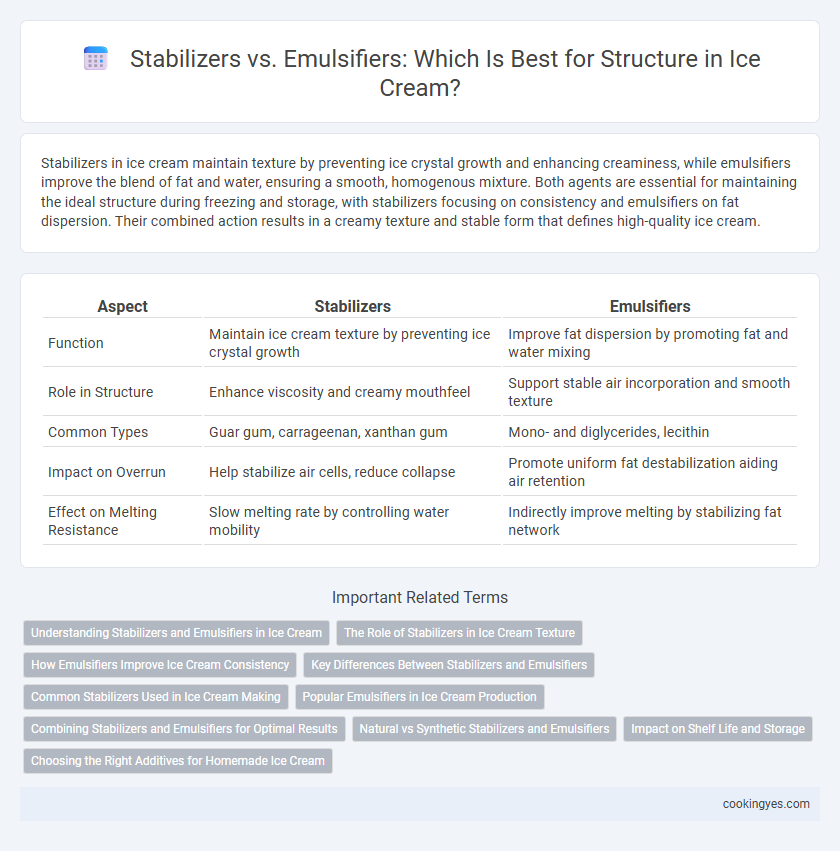Stabilizers in ice cream maintain texture by preventing ice crystal growth and enhancing creaminess, while emulsifiers improve the blend of fat and water, ensuring a smooth, homogenous mixture. Both agents are essential for maintaining the ideal structure during freezing and storage, with stabilizers focusing on consistency and emulsifiers on fat dispersion. Their combined action results in a creamy texture and stable form that defines high-quality ice cream.
Table of Comparison
| Aspect | Stabilizers | Emulsifiers |
|---|---|---|
| Function | Maintain ice cream texture by preventing ice crystal growth | Improve fat dispersion by promoting fat and water mixing |
| Role in Structure | Enhance viscosity and creamy mouthfeel | Support stable air incorporation and smooth texture |
| Common Types | Guar gum, carrageenan, xanthan gum | Mono- and diglycerides, lecithin |
| Impact on Overrun | Help stabilize air cells, reduce collapse | Promote uniform fat destabilization aiding air retention |
| Effect on Melting Resistance | Slow melting rate by controlling water mobility | Indirectly improve melting by stabilizing fat network |
Understanding Stabilizers and Emulsifiers in Ice Cream
Stabilizers in ice cream such as guar gum and carrageenan enhance texture by preventing ice crystal growth, ensuring a smooth and creamy consistency. Emulsifiers like lecithin optimize fat dispersion, improving air incorporation and overall mouthfeel. Together, stabilizers and emulsifiers maintain structural integrity, enhancing scoopability and sensory experience.
The Role of Stabilizers in Ice Cream Texture
Stabilizers in ice cream play a crucial role in maintaining texture by preventing the formation of large ice crystals and controlling water mobility, which enhances smoothness and creaminess. Common stabilizers like guar gum, carrageenan, and xanthan gum create a viscous network that traps air and fat, contributing to the ice cream's body and resistance to melting. Their interaction with proteins and fat globules ensures a consistent, desirable mouthfeel throughout storage and consumption.
How Emulsifiers Improve Ice Cream Consistency
Emulsifiers enhance ice cream consistency by promoting the uniform dispersion of fat droplets, preventing coalescence and contributing to a smoother texture. They improve the air-cell structure, leading to better overrun and a creamier mouthfeel. Compared to stabilizers, emulsifiers play a crucial role in achieving a stable, homogeneous mixture that resists ice crystal growth during freezing and storage.
Key Differences Between Stabilizers and Emulsifiers
Stabilizers in ice cream primarily maintain texture by preventing ice crystal growth, ensuring a smooth and creamy consistency over time. Emulsifiers improve the mixture's uniformity by helping fat and water blend seamlessly, enhancing air incorporation and creaminess. While stabilizers focus on moisture retention and texture stability, emulsifiers are critical for fat dispersion and improving overall mouthfeel.
Common Stabilizers Used in Ice Cream Making
Common stabilizers used in ice cream making include guar gum, carrageenan, and xanthan gum, which help maintain a smooth texture by preventing ice crystal formation and improving water retention. These stabilizers enhance the creaminess and shelf life of the product by stabilizing the mixture and reducing melt-down rates. Their effective incorporation ensures consistent structure and quality in the final ice cream product.
Popular Emulsifiers in Ice Cream Production
Popular emulsifiers in ice cream production include lecithin, mono- and diglycerides, and polysorbates, which improve the dispersion of fat and water phases to create a uniform texture. These emulsifiers enhance the creaminess and stability of ice cream by reducing surface tension between fat droplets, preventing coalescence during freezing. Their use alongside stabilizers ensures smooth mouthfeel and resistance to ice crystal formation, optimizing overall product quality.
Combining Stabilizers and Emulsifiers for Optimal Results
Combining stabilizers like guar gum or carrageenan with emulsifiers such as lecithin enhances ice cream's texture by improving water retention and fat dispersion, resulting in a creamier and more stable product. Optimizing the balance between these additives controls ice crystal formation and prevents phase separation, ensuring smoothness and consistent mouthfeel. This synergy is essential for maintaining structural integrity during freezing and storage, ultimately enhancing sensory quality and shelf-life.
Natural vs Synthetic Stabilizers and Emulsifiers
Natural stabilizers like guar gum and xanthan gum create a smooth, creamy ice cream texture by preventing ice crystal growth, while synthetic stabilizers such as cellulose derivatives offer enhanced control over viscosity. Emulsifiers, including natural lecithin from soy or egg yolk and synthetic mono- and diglycerides, improve fat dispersion and air incorporation, resulting in a stable, uniform structure. Choosing between natural and synthetic options impacts not only texture and melt resistance but also consumer preferences for clean-label ingredients.
Impact on Shelf Life and Storage
Stabilizers in ice cream, such as guar gum and carrageenan, enhance texture by preventing ice crystal growth, significantly extending shelf life and improving storage stability. Emulsifiers like lecithin and mono- and diglycerides improve fat dispersion and air incorporation, contributing to creaminess but have a lesser direct impact on preventing ice recrystallization over time. Effective use of stabilizers and emulsifiers together ensures optimal ice cream structure, maintaining quality during extended frozen storage.
Choosing the Right Additives for Homemade Ice Cream
Stabilizers such as guar gum and xanthan gum enhance homemade ice cream's texture by preventing ice crystal growth, ensuring a smooth, creamy consistency. Emulsifiers like lecithin and mono- and diglycerides improve fat dispersion, promoting a uniform and stable mixture that enhances mouthfeel. Selecting the right combination of stabilizers and emulsifiers tailored to the recipe helps achieve optimal structure, creaminess, and scoopability in homemade ice cream.
Stabilizers vs Emulsifiers for Structure Infographic

 cookingyes.com
cookingyes.com